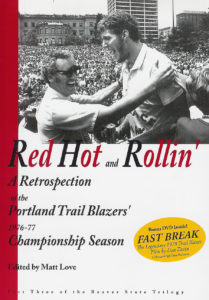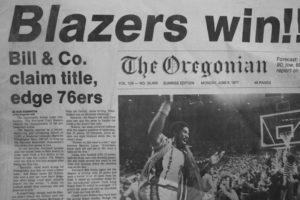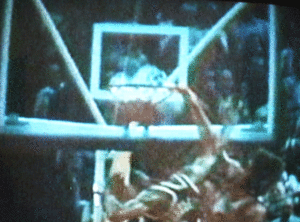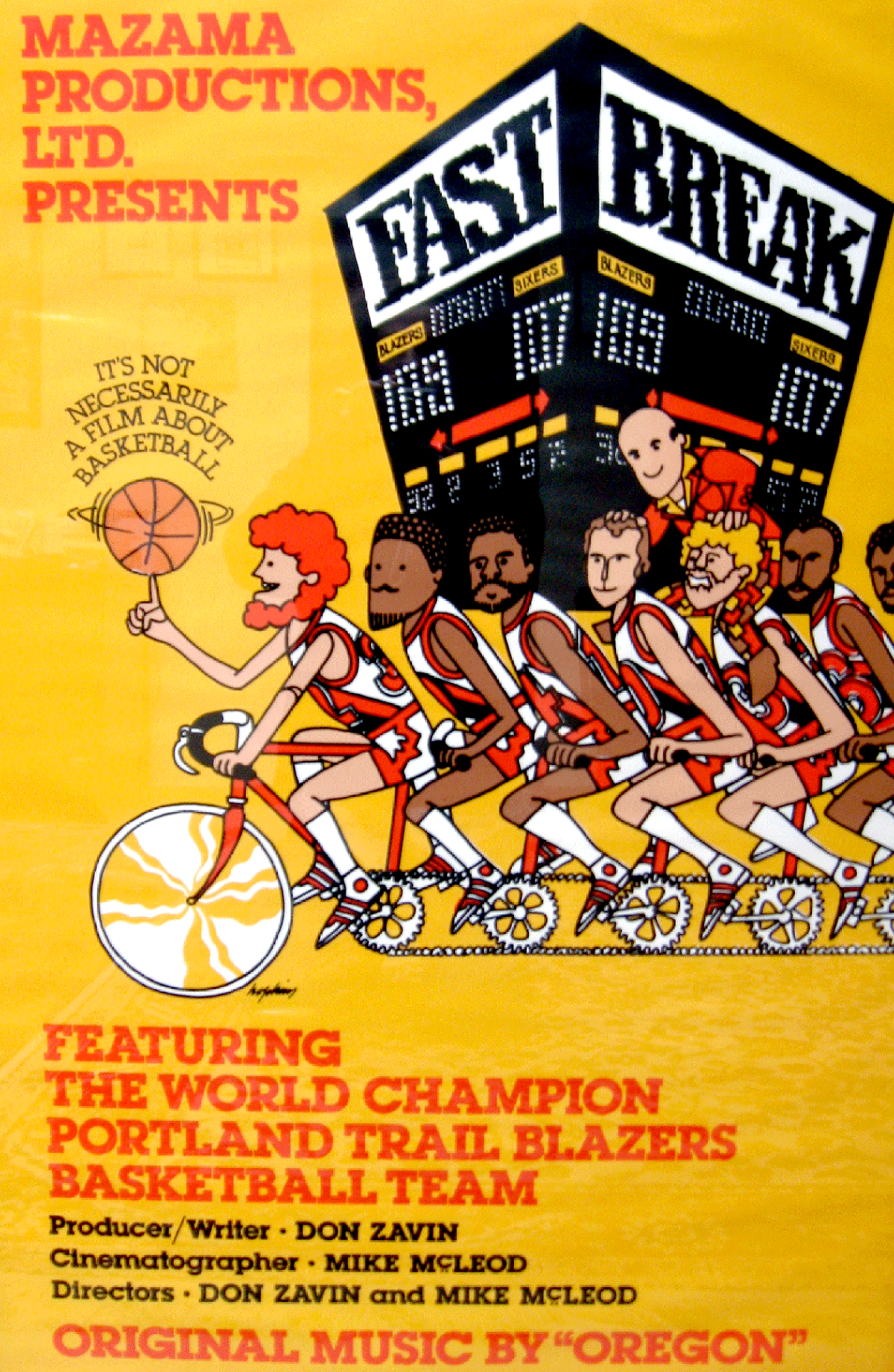Ten Year Anniversary of Red Hot and Rollin’ and the Stoner Legend of Fast Break
Ten years ago this month, I released the third installment of what I called the Beaver State Trilogy, Red Hot and Rollim,’ an anthology of essays, memoirs, oral histories, primary source documents, rare photographs and a long lost film documentary commemorating the 30th anniversary of the Portland Trail Blazers 1977 NBA title.
 I had some memorable experiences compiling and promoting the book. Three stand out: 1) meeting and interviewing the legendary power forward of that championship team, Maurice Lucas; 2) a walk with old friend along the promenade in Oregon City after a gig; 3) a sort of gig in Monmouth, Oregon.
I had some memorable experiences compiling and promoting the book. Three stand out: 1) meeting and interviewing the legendary power forward of that championship team, Maurice Lucas; 2) a walk with old friend along the promenade in Oregon City after a gig; 3) a sort of gig in Monmouth, Oregon.
The 2200-book press run sold out in a couple of years, the fastest-selling Nestucca Spit Press book of all time.
I was thinking about the book and the Blazers last Easter Sunday as I watched them battle the Golden State Warriors in game one of the first round of the playoffs. Ten years ago the team had the first pick in the draft and chose Greg Oden over Kevin Durant, the same Kevin Durant who scored 32 points in a win against the Blazers in game one. If the Blazers had chosen Durant over Oden, the last decade for the franchise would have surely turned out vastly different. So it goes.
As I watched the game, I also thought about the DVD I included in the anthology, Fast Break, a documentary released in 1978 that I discovered entombed in a Gresham warehouse and was surely buried for all time until I resurrected it. As I have written elsewhere and promulgated hundreds of times at public presentations, Fast Break is indisputably the greatest stoner sports film in the history of American cinema. It must be seen to be believed and even then you won’t believe it.
Now that Oregon has become one of the leading states in the pot business, the film takes on fresh historical significance and adds another layer of stoniness. This is particularly true once you realize that the secret weapon the Blazers used to defeat the 76ers was marijuana. I have never written this story for publication but I interviewed the number one participant in the story (it wasn’t a player, but actually a dealer, THE DEALER, and I corroborated his sensational claims). Perhaps one day, I’ll write it up for the record. It’s a helluva of tale.
Fast Break’s movie poster tagline was: “It’s not necessarily a film about basketball.”
That’s for damn sure. Fast Break is prima facie a documentary, but really it’s more of a stoned contemplation of a subject than anything else. That its subject was a professional basketball team led by its counterculture star center, Bill Walton, unselfishly winning an NBA Title in 1977 in Zen Buddhist-style, just makes the film’s treatment of the content all the more incredible and quintessentially Oregon.
A Portland filmmaker named Don Zavin (died in 1998) conceived and directed Fast Break as an independent production. He shot the film in the spring and summer of 1977 and it debuted at the Fox Theater in downtown Portland in September of 1978, showed there in an exclusive engagement for one week, played one more time at the Northwest Film Study Center in October, and then was never shown in public again.
 In the spring of 1977 as the Blazers launched their improbable playoff run, Zavin began shooting Fast Break. He followed the team through their victory over the 76ers, the summer, and next fall’s training camp and preseason. How he convinced the Blazer front office, coaching staff, Walton and the other players to cooperate so fully in this intimate and unorthodox project, quite possibly unprecedented in the annals of professional sports, is unknown to me or anyone still alive connected to the film’s production.
In the spring of 1977 as the Blazers launched their improbable playoff run, Zavin began shooting Fast Break. He followed the team through their victory over the 76ers, the summer, and next fall’s training camp and preseason. How he convinced the Blazer front office, coaching staff, Walton and the other players to cooperate so fully in this intimate and unorthodox project, quite possibly unprecedented in the annals of professional sports, is unknown to me or anyone still alive connected to the film’s production.
It could never happen today.
Fast Break opens with a psychedelic animated dedication to a member of the film crew, (Patrick Stuckey) who drowned in the Warm Springs River while on location in Central Oregon making the movie. From there, Fast Break embarks on one hour and fifty-seven- minute trip, and I mean trip, that cuts back and forth between the playoffs, Walton’s summer vacation, including his bicycle trip down Highway 101 on the North Oregon Coast and his basketball clinic on the Warm Springs Indian Reservation.
 Space constraints here limit a full review of the sheer far out scenes that comprise Fast Break. Let me tease out a few: Fast Break captures in almost operatic fashion Walton’s legendary jam over Kareem Abdul-Jabber in the playoffs, Walton dousing the Championship Trophy with beer, Maurice Lucas visiting inmates at the Oregon State Penitentiary, an obviously stoned Walton ordering breakfast at an Oceanside diner, and an apparently intoxicated Walton receiving ceremonial chieftain honors from an Indian…around a bonfire!
Space constraints here limit a full review of the sheer far out scenes that comprise Fast Break. Let me tease out a few: Fast Break captures in almost operatic fashion Walton’s legendary jam over Kareem Abdul-Jabber in the playoffs, Walton dousing the Championship Trophy with beer, Maurice Lucas visiting inmates at the Oregon State Penitentiary, an obviously stoned Walton ordering breakfast at an Oceanside diner, and an apparently intoxicated Walton receiving ceremonial chieftain honors from an Indian…around a bonfire!
Like I said, it must be seen to be believed.
Fast Break suffered the cruel marketing misfortune to debut in Portland at the precise moment when Oregon had come to loathe Bill Walton because of his accusations of medical malpractice against the team and demand for a trade. It was released in 1978 to mediocre Portland reviews and then disappeared until I found it in 2007 and bankrolled its transfer from film to DVD.
They just didn’t get it then. We do now.
Hit your local dispensary, load up, invite friends over, even the ones who don’t care about professional basketball, find the film on YouTube, and get ready to have your mind utterly blown.
(If you found this post enjoyable, thought provoking or enlightening, please consider supporting a writer at work by making a financial contribution to this blog or by purchasing an NSP book.)

